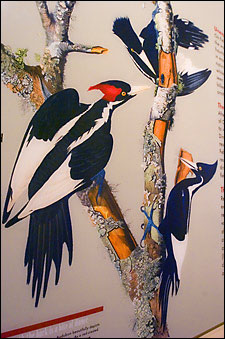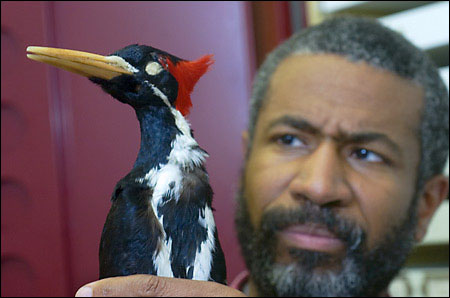Exhibit explores ivory-billed mystery
HMNH highlights Harvard collection, current debate


The ivory-billed woodpecker, with its tall crest and black and white markings, is a dramatic bird.
Or was a dramatic bird.
Which view you hold may depend on whether you believe those who claim they recently rediscovered the bird decades after it was thought to have gone extinct. An exhibit at the Harvard Museum of Natural History can help visitors decide for themselves.
The exhibit, which opened in February, highlights both the newsmaking headlines of the bird’s supposed resurrection and the biggest factor that is keeping the skeptics skeptical: its similarity to the pileated woodpecker.
Since Harvard has the world’s largest collection of ivory-billed woodpeckers – and one of just three nesting cavities in museums anywhere, it is important, exhibit organizers said, that the museum illuminate for the public what can be an arcane debate over wing color and bird calls.
“We have the best collection in the world. That makes it all the more important we educate the public about this event,” said Scott Edwards, Alexander Agassiz Professor of Zoology and curator of ornithology in the Museum of Comparative Zoology.
The ivory-billed woodpecker was thought to have gone extinct in the United States after the last accepted sighting in 1944. The bird declined after its native swampy southern forests were clear-cut in the decades after the Civil War.
The regrowth of some of those forests have provided new habitat for the birds today, and at least a handful may have survived the intervening decades as the trees regrew. Though there were scattered sightings reported since 1944, the bird’s similarity to the pileated woodpecker kept most authorities skeptical.
‘The Miracle Bird: The Story of the Ivory-billed Woodpecker’ features an exquisite ivory-billed specimen and rare nest cavity from the ornithological collections of Harvard University and 1935 video footage of an ivory-billed woodpecker from the Cornell Lab of Ornithology. This mini-exhibit recounts the ivory-billed woodpecker¹s story from its decline around the turn of the 20th century to its possible rediscovery in 2004. The Harvard Museum of Natural History has public entrances located at 26 Oxford St. and at 11 Divinity Ave., Cambridge, Mass. All of the HMNH exhibits, including the Glass Flowers Gallery, are open daily from 9 a.m to 5 p.m., except for some holidays. Go to http://www.hmnh.harvard.edu/ for admission prices or call (617) 495-3045.
That changed in 2004, when Gene Sparling reported seeing the bird on the Cache River in Arkansas. That was followed up a few weeks later by a sighting by Tim Gallagher, editor of the Cornell University Lab of Ornithology’s Living Bird magazine, and Bobby Harrison, associate professor at Oakwood College, in the same area. That second sighting brought birders and experts flooding into the region.
Though more evidence has emerged since then, including a brief, grainy video that some say shows the bird clinging to a tree and then flying off, debate over whether the bird has been rediscovered has continued.
Edwards said the exhibit seeks to present both sides and provide a side-by-side comparison of the ivory-billed and pileated woodpeckers so visitors can see the two birds for themselves.
The exhibit features large images of the woodpeckers, video footage from a 1935 expedition by Cornell University researchers, and audio of the birds’ calls and the distinctive sounds they make when rapping their bills on tree trunks. It also includes a section of tree trunk with a nest cavity in it and a mounted specimen of the species.
New research mentioned in the exhibit highlights the importance of Harvard’s collections for ongoing research. Using tissue samples from the University’s ivory-billed woodpecker collection – housed at the Museum of Comparative Zoology – researchers analyzed the birds’ DNA. The results provide a reference that can be used on feathers, feces, or other items from the field to confirm the existence of the ivory-billed woodpecker even in the absence of conclusive photographic or video evidence.
“It is easier to distinguish an ivory-billed and a pileated from their DNA,” Edwards said. “If we find a feather in a nest cavity, we’d immediately know.”
Related links:
Share this article
- Ivory-billed woodpecker: Ornithology’s holy grail: Birdman Gallagher recounts the day of discovery
- Collection takes flight: Edwards studies birds with genetic databases, not binoculars
- A voice for the wilderness: E.O. Wilson talks of striking a balance between humans’ needs and nature’s




